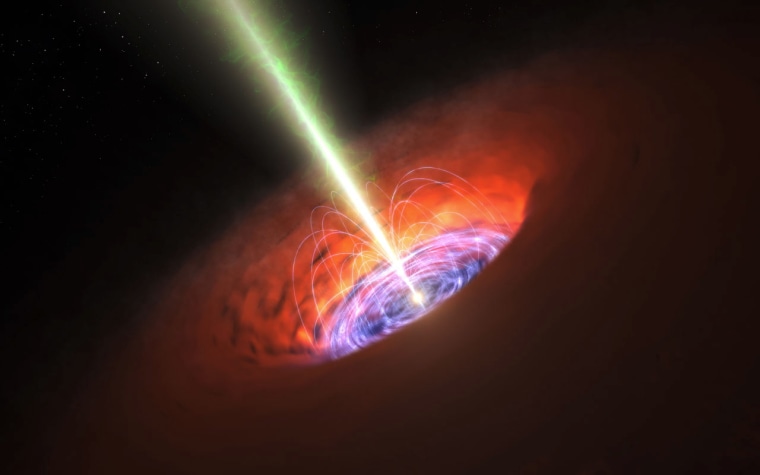Black holes may sport a luxurious head of "hair" made up of ghostly, zero-energy particles, says a new hypothesis proposed by Stephen Hawking and other physicists.
The new paper, which was published online Jan. 5 in the preprint journal arXiv, proposes that at least some of the information devoured by a black hole is stored in these electric hairs.
Still, the new proposal doesn't prove that all the information that enters a black hole is preserved.

"The million-dollar question is whether all the information is stored in this way, and we have made no claims about that," said study author Andrew Strominger, a physicist at Harvard University in Massachusetts. "It seems unlikely that the kind of hair that we described is rich enough to store all the information."
Related: Stephen Hawking Talks Killer Robots, Favorite Song in Reddit AMA
According to Einstein's theory of general relativity, black holes are extremely dense celestial objects that warp space-time so strongly that no light or matter can escape their clutches. Some primordial black holes formed soon after the Big Bang and may be the size of a single atom yet as massive as a mountain, according to NASA. Others form as gigantic stars collapse in on themselves, while supermassive black holes lie at the hearts of almost all galaxies. [8 Ways You Can See Einstein's Theory of Relativity in Real Life]
In the 1960s, physicist John Wheeler and colleagues proposed that black holes "have no hair," a metaphor meaning that black holes were shorn of all complicated particularities. In Wheeler's formulation, all black holes were identical except for their spin, angular momentum and mass.
Then, in the 1970s, Stephen Hawking proposed the notion now called Hawking radiation. In this formulation, all black holes "leak" mass in the form of ghostly quantum particles that escape over time. Eventually, Hawking radiation causes black holes to evaporate altogether, leaving a single, unique vacuum. The vacuums left by these black holes, according to the original theory, would be identical, and thus incapable of storing information about the objects from which they were formed, Strominger said.
Since the Hawking radiation leaking from a black hole is completely random, that would mean black holes lose information over time, and there would be no way of knowing much about the celestial objects that formed the black holes. Yet that notion creates a paradox, because on the smallest scale, the laws of physics are completely reversible, meaning information that existed in the past should be theoretically recoverable. In recent years, Hawking has walked back the notion of information loss and conceded that black holes do store information after all.
In the past several years, Strominger has been dismantling some of these notions. First, he asked the question: What happens if you add a "soft" photon, or a particle of light with no energy, to the vacuum left behind after a black hole evaporates?
Related: Astronomers Detect Visible Light From Black Hole for First Time
Though most people have never heard of soft photons, the particles are ubiquitous, Strominger said. (Other particles, called soft gravitons, are hypothetical quantum particles that transmit gravity. Though they have never been detected, most physicists believe these particles exist and are also incredibly abundant, Strominger said). [Beyond Higgs: 5 Other Particles That May Lurk in the Universe]
"Every collision at the Large Hadron Collider produces an infinite number of soft photons and soft gravitons," Strominger said. "We're swimming in them all the time."
After working through the equations, he — together with Hawking and Malcolm Perry, who are both physicists at the University of Cambridge in England — found that the black hole vacuum would have the same energy but different angular momentum after the addition of a soft photon. That meant the vacuum state of an evaporated black hole is a kind of celestial snowflake, with its individual properties dependent on its origin and history.
"Far from being a simple, vanilla object, it's like a large hard drive which can store essentially an infinite amount of information in the form of these zero-energy photons and gravitons," Strominger told Live Science.
The new work is an extension of a short paper Hawking put out in 2014, which argued that the event horizon, or the point of no return before an object would get swallowed into a black hole forever, may not be a fixed boundary. The new paper posits that hairs of soft photons and gravitons fringe a black holes' event horizon.
This is a condensed version of a report from Live Science. Read the full report. Follow Tia Ghose on Twitter and Google+. Follow Live Science @livescience, Facebook & Google+.
More from Live Science
- 8 Shocking Things We Learned From Stephen Hawking's Book
- The 9 Biggest Unsolved Mysteries in Physics
- Wacky Physics: The Coolest Little Particles in Nature